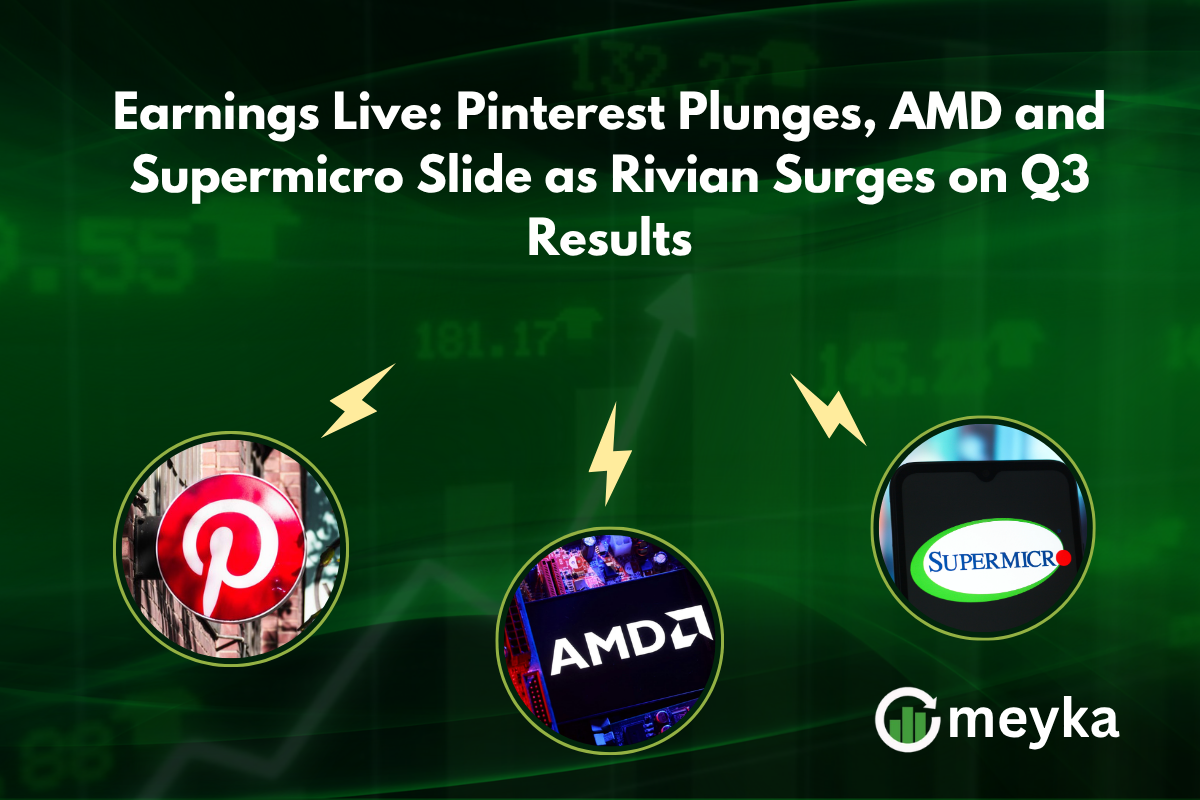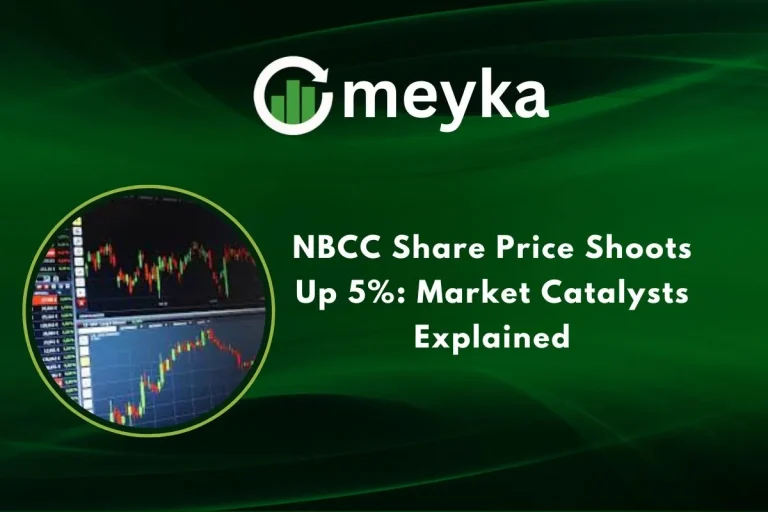Earnings Live: Pinterest Plunges, AMD and Supermicro Slide as Rivian Surges on Q3 Results
This earnings week moved markets. Big names posted results that matter to tech and EV investors. AMD reported record revenue.
Rivian (RIVN) beat sales forecasts while still wrestling with profitability. Pinterest had a mixed quarter that spooked short-term traders. This article breaks down the numbers, the market reaction, and what it means for investors.
What Happened In Earnings, At A Glance
AMD (Advanced Micro Devices) posted a record quarter with revenue and profit beats that reflect strong demand for data-center chips and AI accelerators. Management guided up, but the stock showed mixed intraday moves as investors digested margins and forward assumptions.
Rivian reported a sharp revenue rise and delivered more vehicles than the street expected, powering a positive top-line beat but losses remain and investors are split on durability.
Pinterest showed revenue growth but market reaction was negative as investors focused on guidance and advertising trends. Live coverage captured rapid stock swings across the tech space.
Earnings Detail, Numbers And Context
AMD’s Q3 results included record revenue and rising data-center sales. The quarter highlights AMD’s push into AI infrastructure with EPYC and Instinct lines. Management reiterated focus on scaling AI chips and systems. These figures back the thesis that semiconductors tied to AI remain core market drivers.
Why does this matter? Data-center and AI spending is a multi-year tailwind. But high growth invites high expectations and that makes volatility likely after each earnings print.
Rivian, Growth With Caveats
Rivian’s revenue surged year-over-year, driven by more deliveries and higher ASPs. Yet margins and free cash flow remain the anchor for skeptical investors. The company reiterated R2 development and capacity expansion, underlining a pivot from pure growth to scaling efficiency.
What does this mean for investors? Delivery beats boost confidence in product demand, but profitability timelines still matter. Expect the market to reward operational milestones as much as revenue growth.
Pinterest And Ad-Sensitivity
Pinterest posted growth but guidance and ad-metric softness spooked traders. Social and ad-driven platforms still face cyclical ad spending and shifting CPCs. Short-term stock moves often overreact; long-term value depends on user engagement and monetization per user.
Market Reaction, Social Chatter And Sentiment
Social feeds lit up as earnings headlines dropped. Financial commentators and earnings-quote aggregators amplified the highlights and controversial lines from calls.
For example, TheTranscript_ curates notable call quotes that traders share for quick takeaways, while accounts like WOLF_Financial and quant voices such as alojoh offer real-time readouts and sentiment clues. These posts often accelerate intraday flows and serve as a quick lens into investor mood.
Why do tweets matter during earnings? Because traders and algos react fast to bite-sized quotes. Social posts compress calls into tradeable signals that move momentum.
AI, Investing And Research Signals
Artificial intelligence is now a dominant theme behind chip spending and software monetization. Analysts used AI-driven models to parse call language and detect forward-looking intent. This kind of AI Stock research layer helps identify which companies are truly scaling AI revenue versus those that only mention AI as a growth vector. The nuance matters for positioning.
Investor tip: Watch the AI revenue cadence (what percent of growth is AI-related) rather than just the buzzwords.
What Analysts And Competing Coverage Missed Deeper Angles
Competitors often focus on single headlines: beat or miss. A deeper read shows three things investors should note:
- Mix matters as much as top-line rising revenue with narrowing product margins, tells a different story than revenue with expanding margins.
- Delivery cadence and backlog for EVs, delivery and ASP trends reveal real demand strength beyond incentives.
- Guidance language management tone on supply, channel inventory, and AI roadmap often predicts the next quarter’s surprises. Earnings transcripts and curated quotes help here.
Practical Takeaways For Investors
- Holdings tied to AI infrastructure: stay focused on earnings quality and margin drivers, not just revenue headlines.
- EV exposure: separate unit demand signals from one-off price or incentives. Look for sustainable gross-profit trends.
- Ad-driven platforms: watch forward guidance and user engagement metrics, not just monthly active users.
What should a retail investor do now? Review position size, check if thesis (AI adoption, EV scale, ad monetization) still holds, and use earnings volatility to rebalance, not to panic-sell.
Conclusion
This earnings cycle shows a clear split: AI and data-center exposure is driving outsized revenue gains for some firms, while others still face ad or margin headwinds. Short-term volatility will remain high as markets parse guidance and execution.
For investors, the rule is simple: trust the quality of earnings and operational progress, not only headlines. Use curated social signals for speed, but ground decisions in the numbers. Earnings season remains the best time to separate speculation from sustainable business improvement.
Key takeaways: Record revenue can coexist with stock weakness; delivery beats need margin proof; and AI isn’t a one-word thesis, it’s a measurable revenue path. Stay alert, read the calls, and let data guide allocation.
FAQs
CP Q3 net income and EPS vary by year but the railway usually posts solid freight revenue growth driven by grain, intermodal and bulk. Investors check the latest CP press release or Yahoo Finance earnings page for the exact quarter’s EPS and revenue figures.
AMD usually dips when guidance looks softer than expected, AI chip revenue pacing looks slower, or margins disappoint. Macro risk off, yields, or big profit taking after a rally can also trigger sharp AMD pullbacks.
Analysts do not expect AMD to hit $1000 any time soon because that would need massive multi-year earnings growth. Stock price targets remain way below that level across Wall Street models.
The 7 percent rule is a risk control idea where traders cut a losing position if it falls about 7 percent below their buy price. It is meant to protect capital and stop big loss spirals.
There is no safe or reliable way to guarantee that kind of return in 30 days. Extreme leverage or gambling-like methods can also wipe out all capital. The only proven path is patient compounding and controlled, long-term investing.
Disclaimer
The content shared by Meyka AI PTY LTD is solely for research and informational purposes. Meyka is not a financial advisory service, and the information provided should not be considered investment or trading advice.






